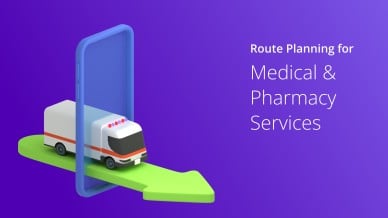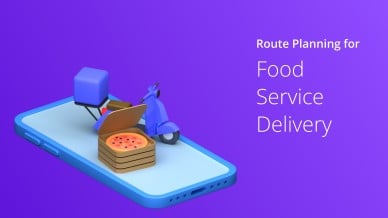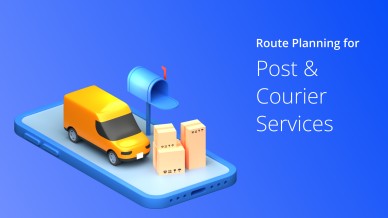Poor routes mean poor results. They result in your transportation and overtime expenses going up, customers becoming furious, and your profit margins plummeting. Of course, no one wants to plan inefficient routes. Yet, many logistics companies and field service businesses end up doing so because they follow the same old-school process to plan a driving route and thus get the same results they have been getting for years. No improvement and so no growth.
So, what exactly can you do to avoid making the same mistake? To start, avoid the five mistakes below.
#1 Planning Routes Manually
Avoid planning routes using pen and paper. Manual route planning simply cannot guarantee accuracy because too much guesswork is involved. It cannot solve your vehicle route problem and traveling salesman problem. Just consider the following:
- Which areas in your routes could have heavy rain or showers in an hour?
- Which routes might suddenly have become one-ways?
- What’s the real-time traffic situation of a particular area through which your drivers need to drive?
- Which areas have low-bridges and are not apt for transporting long items?
- Which is the quickest or shortest route?
The list of problems will only increase if you start covering new routes and acquiring more customers. Neither you nor your drivers will be familiar with the routes and your manual route planning could be in vain.
Read these seven stats that show why you should ditch the manual route planning process to plan a driving route with multiple stops.
#2 Not Collecting Data of Historical Performance
You can’t improve if you don’t know what to improve. For example, if you don’t collect data to analyze what went wrong one time, you’ll keep repeating the same mistake and getting the same results.
So, when a customer complains about delayed delivery, identify what went wrong. Was your driver stuck in traffic and, if so, in which area was the traffic congestion? Also, is traffic congestion usually high in that area during the time your driver passed through, or was it unusual? The amount of data you need to collect only increases if you have multiple drivers who make multiple stops.
Long story short, be informed about your routing activities and performance so that you can make your next move foolproof.
#3 Relying on Google Maps for Multi-Stop Routing
A free route planner like Google Maps is perfect for planning a route for one driver who has five or fewer stops to make, especially if there are no constraints (for example, delivery time windows) and you can manually determine the sequence for the addresses. However, when you need to plan a driving route with multiple stops for multiple drivers, Google Maps simply won’t cut it.
Want To See For Yourself How Route4Me Can Boost Your Profits?

The app can’t optimize the order of stops for you and your drivers will end up traveling more than necessary, which means you’ll pay for more wages and fuel than necessary. To top it all of, your drivers might arrive late, which will upset your customers and damage your reputation. This is because Google Maps will give you the time and distance for a regular vehicle, which is often completely different from what a larger commercial vehicle would do. For example, a Google Maps route might take you through a low-clearance canopy road that won’t work when you have a tall commercial truck.
#4 Not Inspecting Vehicles Before Putting Them on the Road
You might be wondering how vehicle inspection is related to route planning. Well, it is very much related. Let’s say you have planned well-optimized routes (meaning all your drivers should now be able to make timely deliveries) and yet you still get a complaint from a customer about a no-show. How is that possible? After calling up your driver, you might learn that he is stuck in a deserted area because of a breakdown.
Now consider the aftermath. That driver was supposed to make multiple stops, not just the one. How long before the vehicle is up and running again? Meanwhile, how can you ensure the remaining deliveries aren’t affected? You may ask your other drivers close by to make it up, but how can they do it? What process do you have in place?
This does happen and can happen with you too. According to a survey, vehicle downtime costs between $448 and $760 per vehicle each day. But, you could avoid such instances and the cost just by maintaining your vehicles at regular intervals. So, change the air filters, replace the spark plugs and radiator fluid, and change the brake pads whenever needed. Vehicle maintenance is important not just for ensuring timely deliveries, but also to keep your drivers safe on the road.
#5 Unbalanced Workload Distribution
An unbalanced workload means some of your drivers might be overworked, while others have nothing to do. This will lead to more empty vehicles doing rounds and increased fuel expenses and wages.
Add to it the sheer dissatisfaction of your drivers. The overworked drivers will be frustrated because of the huge workload (even though they will earn more incentives), while the underworked drivers will complain about not getting the opportunity of earning incentives. This could lead to driver attrition and difficulty in retaining and attracting the best drivers.
What’s the Solution?
Adopt a free route planner unlimited stops for dynamic routing and improved dispatching efficiency. Such software will plan the most optimal driving route in just 30 seconds while factoring in weather, traffic, one-ways, weight, load, height, sunrise, sunset, time windows, avoidance zones, and many other constraints. Imagine how much time you will save which you can then invest in the other areas of business which matter the most.
The best route planners such as Route4Me route planner even come with a plethora of powerful features that make trip planning and field operation management much easier. These features include the following:
- eSignature for proof-of-delivery
- Plan driving routes by uploading spreadsheets or other file types
- Reporting and analytics to analyze performance and expenses
- GPS tracking to monitor drivers’ on the road in real-time
- Speed alerts to keep a check on aggressive driving
- Email and SMS notification to keep customers informed about when their delivery is nearby
- Geofencing to automate check-ins and check-outs
- Customer portal to help customers track their own package status
So, how do you plan a driving route?
Want To See For Yourself How Route4Me Can Boost Your Profits?







